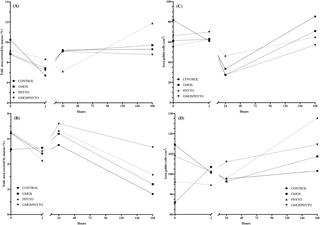Our official English website, www.x-mol.net, welcomes your
feedback! (Note: you will need to create a separate account there.)
Dietary phytogenics and galactomannan oligosaccharides in low fish meal and fish oil-based diets for European sea bass (Dicentrarchus labrax) juveniles: Effects on gut health and implications on in vivo gut bacterial translocation.
PLOS ONE ( IF 2.9 ) Pub Date : 2019-09-18 , DOI: 10.1371/journal.pone.0222063 Silvia Torrecillas 1 , Genciana Terova 2 , Alex Makol 3 , Antonio Serradell 1 , Victoria Valdenegro 4 , Elisabetha Gini 2 , Marisol Izquierdo 1 , Félix Acosta 1 , Daniel Montero 1
PLOS ONE ( IF 2.9 ) Pub Date : 2019-09-18 , DOI: 10.1371/journal.pone.0222063 Silvia Torrecillas 1 , Genciana Terova 2 , Alex Makol 3 , Antonio Serradell 1 , Victoria Valdenegro 4 , Elisabetha Gini 2 , Marisol Izquierdo 1 , Félix Acosta 1 , Daniel Montero 1
Affiliation

|
European sea bass were fed four low FM/FO (10%/6%) diets containing galactomannan oligosaccharides (GMOS), a mixture of garlic oil and labiatae plants oils (PHYTO), or a combination of both functional products (GMOSPHYTO) for 63 days before exposing the fish to an intestinal Vibrio anguillarum infection combined with crowding stress. In order to evaluate functional diets efficacy in terms of gut health maintenance, structural, cellular, and immune intestinal status were evaluated by optical and electron microscopy and gene expression analyses. A semi-automated software was adapted to determine variations in goblet cell area and mucosal mucus coverage during the challenge test. Feeding with functional diets did not affect growth performance; however, PHYTO and GMOS dietary inclusion reduced European sea bass susceptibility to V. anguillarum after 7 days of challenge testing. Rectum (post-ileorectal valve) showed longer (p = 0.001) folds than posterior gut (pre-ileorectal valve), whereas posterior gut had thicker submucosa (p = 0.001) and higher mucus coverage as a result of an increased cell density than rectum. Functional diets did not affect mucosal fold length or the grade of granulocytes and lymphocytes infiltration in either intestinal segment. However, the posterior gut fold area covered by goblet cells was smaller in fish fed GMOS (F = 14.53; p = 0.001) and PHYTO (F = 5.52; p = 0.019) than for the other diets. PHYTO (F = 3.95; p = 0.049) reduced posterior gut goblet cell size and increased rodlet cell density (F = 3.604; p = 0.068). Dietary GMOS reduced submucosal thickness (F = 51.31; p = 0.001) and increased rodlet cell density (F = 3.604; p = 0.068) in rectum. Structural TEM analyses revealed a normal intestinal morphological pattern, but the use of GMOS increased rectum microvilli length, whereas the use of PHYTO increased (p≤0.10) Ocln, N-Cad and Cad-17 posterior gut gene expression. After bacterial intestinal inoculation, posterior gut of fish fed PHYTO responded in a more controlled and belated way in terms of goblet cell size and mucus coverage in comparison to other treatments. For rectum, the pattern of response was similar for all dietary treatments, however fish fed GMOS maintained goblet cell size along the challenge test.
中文翻译:

欧洲鲈鱼(Dicentrarchus labrax)幼鱼的低鱼粉和鱼油基饮食中的膳食植物生长素和半乳甘露聚糖低聚糖:对肠道健康的影响以及对体内肠道细菌易位的影响。
给欧洲鲈鱼喂食了四种低FM / FO(10%/ 6%)饮食,其中含有半乳甘露聚糖低聚糖(GMOS),大蒜油和唇形科植物油的混合物(PHYTO)或两种功能产品的组合(GMOSPHYTO),共63种在将鱼暴露于肠道鳗弧菌感染并伴随拥挤压力的前几天。为了评估功能性饮食在肠道健康维持方面的功效,通过光学和电子显微镜以及基因表达分析来评估结构,细胞和免疫肠道状态。半自动软件适用于在激发试验期间确定杯状细胞面积和粘膜粘液覆盖率的变化。用功能性饮食喂养不会影响生长性能。但是,PHYTO和GMOS膳食包含物降低了欧洲鲈鱼对V的敏感性。经过7天的挑战测试后的安圭拉姆(Anguillarum)。直肠(回肠后瓣)比后肠(回肠前瓣)长(p = 0.001)倍,而后肠粘膜下层较厚(p = 0.001),并且由于细胞密度比直肠高,因此粘液覆盖率更高。功能饮食不影响任一肠段的粘膜折叠长度或粒细胞和淋巴细胞浸润的等级。但是,饲喂GMOS(F = 14.53; p = 0.001)和PHYTO(F = 5.52; p = 0.019)的鱼的杯状细胞覆盖的后肠折叠区域较小。PHYTO(F = 3.95; p = 0.049)减少了后肠杯状细胞的大小,增加了小肠细胞的密度(F = 3.604; p = 0.068)。饮食中的GMOS可减少直肠粘膜下层厚度(F = 51.31; p = 0.001)和增加杆状细胞密度(F = 3.604; p = 0.068)。结构TEM分析显示正常的肠道形态,但使用GMOS可增加直肠微绒毛长度,而使用PHYTO则可增加(p≤0.10)Ocln,N-Cad和Cad-17肠后基因表达。细菌性肠道接种后,与其他处理相比,饲喂PHYTO的鱼的后肠在杯状细胞大小和粘液覆盖率方面的反应更为受控和迟来。对于直肠而言,所有饮食治疗的反应模式均相似,但是在挑战试验中,喂食GMOS的鱼维持了杯状细胞大小。与其他处理方法相比,饲喂PHYTO的鱼的后肠在杯状细胞大小和粘液覆盖率方面的反应更为受控和迟来。对于直肠而言,所有饮食治疗的反应模式均相似,但是在挑战试验中,喂食GMOS的鱼维持了杯状细胞大小。与其他处理方法相比,饲喂PHYTO的鱼的后肠在杯状细胞大小和粘液覆盖率方面的反应更为受控和迟来。对于直肠而言,所有饮食治疗的反应模式均相似,但是在挑战试验中,喂食GMOS的鱼维持了杯状细胞大小。
更新日期:2019-09-19
中文翻译:

欧洲鲈鱼(Dicentrarchus labrax)幼鱼的低鱼粉和鱼油基饮食中的膳食植物生长素和半乳甘露聚糖低聚糖:对肠道健康的影响以及对体内肠道细菌易位的影响。
给欧洲鲈鱼喂食了四种低FM / FO(10%/ 6%)饮食,其中含有半乳甘露聚糖低聚糖(GMOS),大蒜油和唇形科植物油的混合物(PHYTO)或两种功能产品的组合(GMOSPHYTO),共63种在将鱼暴露于肠道鳗弧菌感染并伴随拥挤压力的前几天。为了评估功能性饮食在肠道健康维持方面的功效,通过光学和电子显微镜以及基因表达分析来评估结构,细胞和免疫肠道状态。半自动软件适用于在激发试验期间确定杯状细胞面积和粘膜粘液覆盖率的变化。用功能性饮食喂养不会影响生长性能。但是,PHYTO和GMOS膳食包含物降低了欧洲鲈鱼对V的敏感性。经过7天的挑战测试后的安圭拉姆(Anguillarum)。直肠(回肠后瓣)比后肠(回肠前瓣)长(p = 0.001)倍,而后肠粘膜下层较厚(p = 0.001),并且由于细胞密度比直肠高,因此粘液覆盖率更高。功能饮食不影响任一肠段的粘膜折叠长度或粒细胞和淋巴细胞浸润的等级。但是,饲喂GMOS(F = 14.53; p = 0.001)和PHYTO(F = 5.52; p = 0.019)的鱼的杯状细胞覆盖的后肠折叠区域较小。PHYTO(F = 3.95; p = 0.049)减少了后肠杯状细胞的大小,增加了小肠细胞的密度(F = 3.604; p = 0.068)。饮食中的GMOS可减少直肠粘膜下层厚度(F = 51.31; p = 0.001)和增加杆状细胞密度(F = 3.604; p = 0.068)。结构TEM分析显示正常的肠道形态,但使用GMOS可增加直肠微绒毛长度,而使用PHYTO则可增加(p≤0.10)Ocln,N-Cad和Cad-17肠后基因表达。细菌性肠道接种后,与其他处理相比,饲喂PHYTO的鱼的后肠在杯状细胞大小和粘液覆盖率方面的反应更为受控和迟来。对于直肠而言,所有饮食治疗的反应模式均相似,但是在挑战试验中,喂食GMOS的鱼维持了杯状细胞大小。与其他处理方法相比,饲喂PHYTO的鱼的后肠在杯状细胞大小和粘液覆盖率方面的反应更为受控和迟来。对于直肠而言,所有饮食治疗的反应模式均相似,但是在挑战试验中,喂食GMOS的鱼维持了杯状细胞大小。与其他处理方法相比,饲喂PHYTO的鱼的后肠在杯状细胞大小和粘液覆盖率方面的反应更为受控和迟来。对于直肠而言,所有饮食治疗的反应模式均相似,但是在挑战试验中,喂食GMOS的鱼维持了杯状细胞大小。















































 京公网安备 11010802027423号
京公网安备 11010802027423号